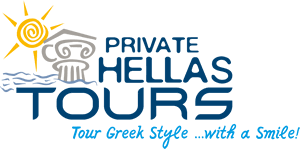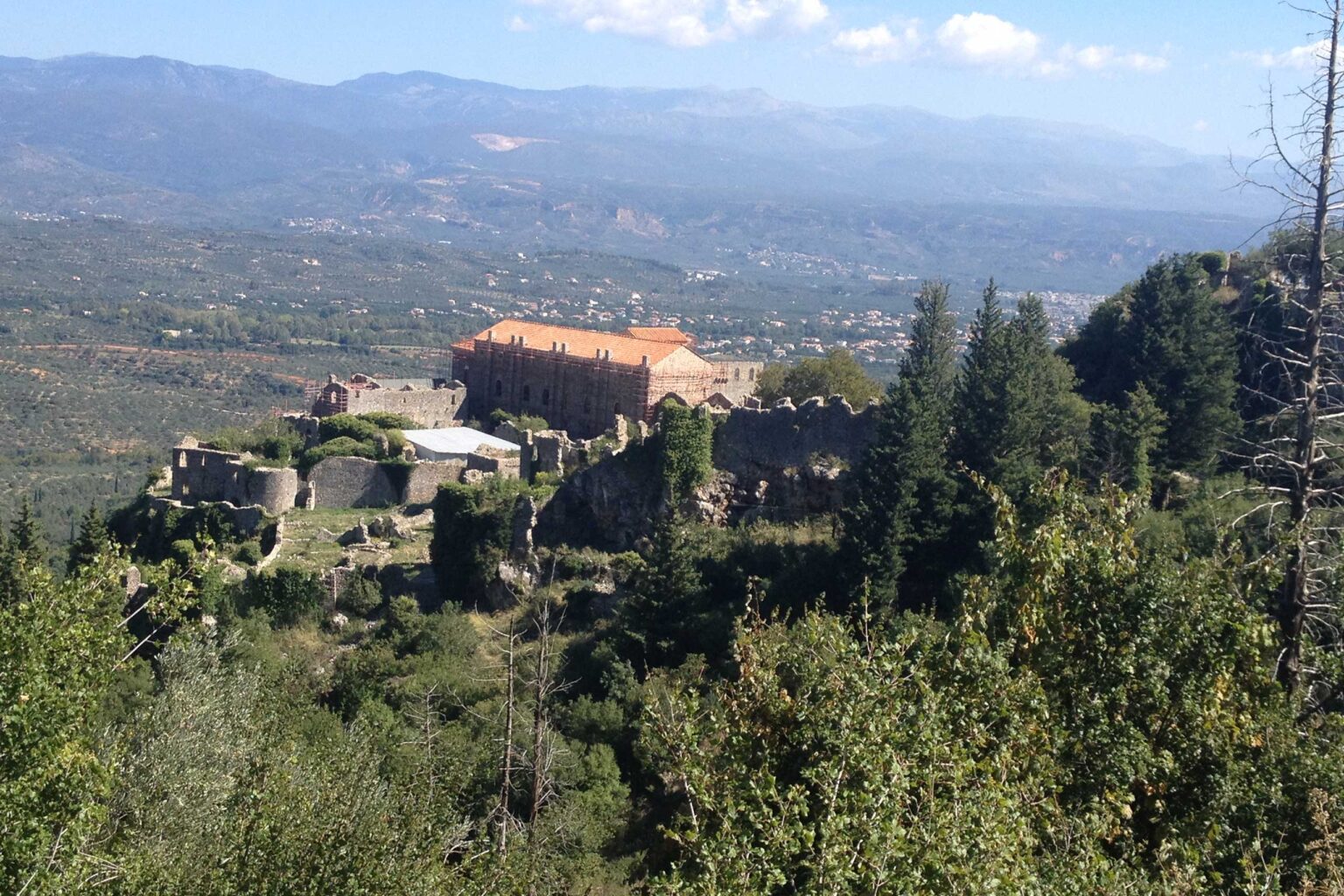We will visit:
- The Corinth Canal
- Ruins of the Ancient Corinth city
- Mycenae
- Nafplion
- Theater of Epidaurus
- Leonida’s Tomb
- Sparta Olive Museum
- Sparta Archaeological Museum
- Mystras Byzantine Castle
Argolis and Sparta two days tour begins driving west along the National Highway, until we reach the Corinth Canal or else Isthmus completed in 1893 – 6 km length, 25m width, 8m depth- which connects the Aegean with the Ionian Sea. Our 15’ stop there gives us the opportunity to take some marvelous pictures and then continue our route until we reach the Ruins of the city of Ancient Corinth. You can see the long rocky wall of Acrocorinth leading to Lechaion (artificial harbor of the Corinthian Gulf) where the road leading to Ancient Agora starts.
The Temple of Apollo (6th c. B.C.-restored 1st c. AD) is the only Greek monument standing, as all others are mainly Roman.
Another interesting spot to see is the museum of Acrocorinth which hosts many objects and findings like the head of Goddess Tyche (Luck), the Bema where Saint Paul preached, and the fountain of Glauke.
Continuing our tour we drive to reach Argolid Epidaurus, known for its sanctuary, as it was the birthplace of Apollo’s son Asclepius the healer. The Asclepeion at Epidaurus was the most celebrated healing center of the Classical world. The prosperity brought by the Asclepeion enabled Epidaurus to construct civic monuments, including the huge Ancient Theater of Epidaurus worldwide known for its perfect acoustics to all 15.000 spectators, its symmetry and beauty, which is used again today for dramatic performances.
The advanced design of the rows of limestone seats filter out low-frequency sounds, such as the murmur of the crowd, and amplify high-frequency sounds from the stage.
Driving through the citrus fruit Argolis plain we reach Nafplion a seaport city expanding up the hillsides near the north end of the Argolic Gulf. Count Ioannis Kapodistrias, first head of state of newly liberated Greece, made it the official capital of the First Hellenic Republic in 1829 until 1834. We will have the opportunity to see Acronafplia the oldest part of the city. Until the thirteenth century, it was a town on its own.
Other fortifications of the city to visit are the Palamidi Castle with 999 steps to climb and Bourtzi island, which is located in the middle of the harbor. There we take lunch at a sea view restaurant.
Leaving Nafplion we visit Mycenae ‘Rich in Gold’, the kingdom of mythical Agamemnon, and the most important and richest palatial centre of the Late Bronze Age in Greece. Its name was given to one of the greatest civilizations of Greek prehistory, the Mycenaean civilization. Great Cyclopean walls surround the almost triangular acropolis, accessed through the famous Lion Gate, symbol of the Mycenaean rulers’ power, like Pelops, father of Agamemnon and Menelaos.
We can see Grave Circle A, whose six large shaft graves contained numerous gold objects and other works of art. Outside the fortification walls, west of the Lion Gate, is Grave Circle B, which encloses fourteen shaft-graves. The “Treasure of Atreus (Agamemnon)” the most impressive of the preserved Mycenaean tholos tombs, situated at Mycenae, on Panagitsa hill, was constructed in ca. 1250 B.C. and was in use for a long period.
Afterwards, we drive towards south-east Peloponnese until we reach the city of Sparta in Laconia for our overnight stay.
Sparta or Lacedaemon, situated on the banks of Eurotas River was a very distinguished city-state of ancient times; a dominant military land power of unequaled reputation as well as a naval power proving its worth during the Greco-Persian Wars. Neither Philip II nor his son Alexander the Great attempted to conquer Sparta itself. Sparta was an Oligarchy ruled by hereditary kings whose duties were primarily religious, judicial, and military but above all it was a military state.
The next day we see the Tomb of Leonidas-Leonidaion in Sparta city (apart from his tomb at Thermopylae)to honor his legendary last stand at the Battle of Thermopylae against the massive Persian army.
Moreover, we visit the Archaeological Museum of Sparta (7 rooms -500m2) housing thousands of findings among which the Temple and Sanctuary of Artemis Orthia, Athena Chalkioikos, Menalaion and the pyramidal column depicting pairs of figures (Orestes and Clytemnestra Menelaus -Eleni).
Additionally, we visit the Museum of the Olive and Virgin Greek Olive Oil in Sparta. It highlights the culture and technology of the olive and olive oil production, which is inextricably linked with the Greek and Mediterranean identity. We are informed about the olive in Greece, its contribution to the economy, its role in nutrition, body care (cosmetic, pharmaceutical uses) and lighting, while special mention is made of its symbolic dimension in religion, mythology, customs and traditions as well as olive’s presence in art. We discover the olive oil production technology from Antiquity until the early industrial era and the know-how of soap-making, domestic and industrial.
Afterwards we take the route of magnificent view towards Mystras Byzantine fortified citadel listed on UNESCO’s World Heritage Sites. Mystras fortress on a steep foothill of Mt. Taygetos, was founded in 1249 by the Frankish leader William II de Villeharduin. After 1262 it came under Byzantine control, and at the middle of the 14th century became the seat of the Despotate of Moreas. In 1448 the last emperor of Byzantium, Constantine XI Palaeologos, was crowned at Mystras. In 1460 the hill was captured by the Turks. It was one of the first castles of Greece to be liberated in 1821. The foundation of modern Sparta by king Otto in 1834 marked the end of the old town’s life. The most important monuments of the site are: The Castle, The Cathedral of St. Demetrios, the Church of Saints Theodore, Church of Our Lady Hodegetria (the Leader of the Way), Church of Aghia Sophia (Holy Wisdom), Monastery of Our Lady Peribleptos, Church of Our Lady Evangelistria (of the Annunciation), Monastery of Our Lady Pantanassa (the Queen of all), Palaces of the Mystras Despots (Kantakouzenoi and Palaeologoi) and Urban buildings.
We conclude our tour by having lunch at a local traditional restaurant and then take our way back to Athens…
Argolis & Sparta Tour Details
Duration : 2 days
Booking Request
Tickets and Opening Hours
Tickets : Full: €6, Reduced: €3
Tickets :
Sparta Archaeological museum : Full : 2€, Reduced : 1€
Sparta Olive Museum : Full :3 €, Reduced : 1,5€
Mystras: Full : 12€, Reduced : 6€
Tickets : Full: €12, Reduced: €6
Tickets : Full: 8€, Reduced: 4€
Palamidi is open every day
Wintertime: 8:30-15:30
From November 1st to March 31st: 08:30-16:00
Summertime:
April to August: 08:00-20:00
September 1st to September 15th: 08:00-19:30
September 16th to September 30th: 08:00-19:00
October 1st -to October 5th: 08:00-18:30
October 16th to October 31st: 08:00-18:00
Good Friday: 12.00-17.00 Holy Saturday: 08.30-16.00
Tickets : Full : 3€, Reduced : 1,5€
- Opening Hours
- 1 March-15 October: 10:00 – 18:00.
- 16 October – 28 February 10:00 – 17:00.
Closed : Every Tuesday
- March 6 (in memory of Melina Mercouri)
- April 18 (International Monuments Day)
- May 18 (International Museums Day)
- June 5 (International Enviroment Day)
- September 27 (International Tourism Day)
- October 28 (Greek National Holiday)
- The last weekend of September (European Heritage Days)
- Sundays from November 1st till March 31st
- The first Sunday of every month except July, August & September
- Admission is free for the students of EU and children under 18 years.
- People with special needs free; there is no ramp and no wheelchair is provided
Your professional driver has limited knowledge of Greek history, mythology as well as contemporary life and traditions. He is not allowed by law to accompany you into the sites and museums; therefore he will be waiting for you at the agreed area.
Private Hellas Tours cooperates with professional, licensed private tour guides, that you can hire and will ride the same vehicle with you, accompany you to the sites and museums and give you detailed information on the history of the landmarks and historical sites.

